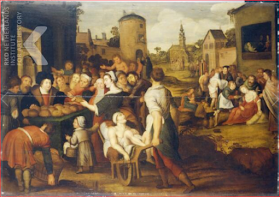Monday, 4 April 2016
Two versions of the 7 Works of Mercy
Tradart, from France, sells on 10 April 2016 an "Attributed to Hieronymus Francken" Works of Mercy, estimated at 4,000 to 6,000 Euro.
They indicate another version by Hieronymus Francken, sold at Christie's in 2008, but fail to mention that the original composition is by Frans Francken I or II and that Hieronymus (as is so often the case) just produces good copies.
The best version by Francken II I could find is in the Manchester Art Gallery and dates to about 1610.
Another version of this work was sold at Christie's in 2014 (found courtesy of RKD)
One with the same direction as the work for sale was at Colnaghi in 2010 (again through RKD), though this one was less similar already.
The oldest work in this series seems to be the above, for sale at Lempertz in 2005. While farther removed from the one for sale, it already has a number of elements that would recur in all later versions, like the V-necked fur coat of the bread distributor behind the clothed table, or the naked man seen on the back behind the fainted, seated woman.
Horta, from Brussels, sells on 17 April 2016 a "17th century Dutch School" Village Feast (sic!) estimated at 5,000 to 6,000 Euro. It has an older attribution to Joost Cornelisz Droochsloot.
Looking at the painting in more detail clearly shows that this as well is a "7 Works of Mercy", with the food and drink to the right, clothing the naked to the left, and so on. Not every village scene with a lot of people on it and some food and drink is a "village feast"...
The compositions are very close to each other, compare e.g. the bottom left of the Horta (the sick, the naked, and the dead) to the Tradart work. But the Horta work is also closer to a number of similar works attributed to Droochsloot. No idea how this curious mixture exactly happened though.
This is an example, from Christie's in 1995 (via RKD). It has similar architecture, similar use of the wine barrel, ...
The Horta painting simply looks a bit too modern to be by Francken, and should be closer to 1650 probably. But the 5,000 Euro estimate looks to be a tad high, even though it is an interesting work. I'ld rather buy the Tradart for 4,000 Euro, but that's maybe simply because the older Flemish art is more to my liking than the slightly boring later Dutch works.
UPDATE: Horta version sold for 4,200 Euro, slightly under estimate, as expected.
UPDATE 2: Horta version now (18 October 2016) for sale at Dorotheum, as a Droochsloot and with the correct description, estimated at 10,000 to 15,000 Euro! Would make a nice profit it this succeeds.









No comments:
Post a Comment